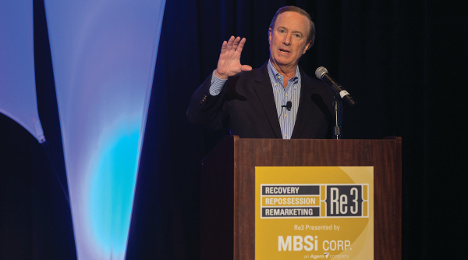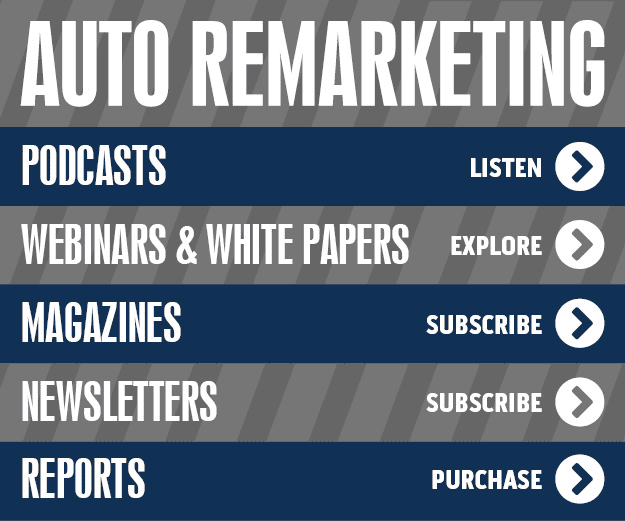Within weeks of reaching a partnership with a subprime auto finance company, AutoGravity — a FinTech developer on a mission to transform auto financing by harnessing the power of the smartphone — announced on Wednesday that potential buyers in 46 states can obtain up to four financing offers on any make, model or trim of new or used vehicle.
Shoppers can receive their offers through four steps on the AutoGravity platform, which can return personalized retail installment contract and lease offers within minutes.
“AutoGravity has brought car finance into the digital age,” said Andy Hinrichs, who became AutoGravity’s founder and chief executive officer after decades as an auto finance executive.
“Our industry-leading technology has been embraced by top banks and captive auto lenders, as well as leading dealer groups who see customers shopping on their smartphones every day,” Hinrichs continued in a news release. “We’ve re-designed the car finance experience, taking it from hours to minutes for car buyers across the country.”
Earlier this month, the firm finalized a partnership with First Investors Financial Services, bringing the subprime auto finance company’s indirect financing business onto the AutoGravity platform.
Based in Irvine, Calif., AutoGravity said it has built other partnerships with the world’s leading banks, captive finance companies and leading dealership groups. As a result, AutoGravity claims to be the only company to successfully bring thousands of dealers and an extensive list of top global finance companies together in a single, convenient digital marketplace.
“To truly empower car buyers with access to every possible vehicle, dealer and finance choice, the AutoGravity platform must be an attractive place for lenders and dealers to do business,” said Serge Vartanov, AutoGravity’s chief marketing officer.
“We’ve spent over a year integrating lenders and dealers into the platform, and we’re now ready for customers across the country to start shopping and financing —making AutoGravity a game-changer in the auto-finance industry,” Vartanov continued.
The app can guide vehicle shoppers through an intuitive four step process:
1. Select any make, model and trim of new or used vehicle available in the United States.
2. Select any dealership from AutoGravity’s proprietary national database; the platform automatically pinpoints the location and shows the closest dealers selling the vehicle.
3. Search for financing for the selected vehicle on a smartphone. Users can scan their driver’s license and connect to social media to quickly pre-fill the finance application.
4. Receive up to four finance offers within minutes. They can select the retail installment contract or lease offer that’s right and head to the dealership to complete the delivery.
“AutoGravity’s highly-streamlined process is designed to address the shopping habits and demands of modern consumers, particularly millennials,” the company said. “This is made possible through AutoGravity’s unparalleled technical expertise, partnerships with the world’s most prominent lenders and a proprietary database of trusted dealerships.
Designed with state-of-the-art security, AutoGravity protects consumers’ information with advanced bank-level encryption and proprietary data security technologies, ensuring sensitive information is processed in a safe and secure way,” the company went on to say.
The app is available for download on from the Apple App Store and from Google Play. AutoGravity is also available as a mobile-responsive web-app at www.autogravity.com.
The American Financial Services Association made the decision not long before the holidays to add another special panel discussion to its Vehicle Finance Conference; a segment dedicated solely to the subprime segment and to assuage concerns of a “bubble.”
In front of a standing-room only audience at the Sheraton New Orleans, a trio of experts from each of the three major credit bureaus to varying degrees all emphasized that there is no bubble, and the amount of subprime auto paper still outstanding is actually less than where it stood before the Great Recession.
AFSA gathered together Equifax chief economist Amy Crews Cutts, Experian senior director of automotive finance Melinda Zabritski and Jason Laky — who is senior vice president and automotive and consumer lending business leader at TransUnion — for a session ahead of the main festivities at the conference that began later on Tuesday.
Each of the experts took turns dissecting various parts of the subprime auto finance market, maintaining that it’s not “bubbling” like some media outlets might speculate while circling back to the mortgage meltdown that derailed the economy.
“People don’t buy cars to flip them. They buy them to get to work,” Crews Cutts said. “There’s definitely not a bubble.”
Later Laky added, “It’s such a different part of the economy than mortgage.” And when speaking about subprime auto paper being booked nowadays, Laky said, “We’re still not even up to where we were back in 2009.”
Zabritski also chimed in, saying, “We had this massive trough in 2009 where there wasn’t any funds to lend. We’re seeing the market turn around with higher scores in longer term loans.”
The 45-minute session moved quickly as the assembled panel touched on elements of the subprime space that are now different than perhaps 10 years ago, especially with the advent of alternative credit data that can present a more detailed background about a consumer’s past performance.
However, each credit bureau shared some concerns about subprime auto finance.
Laky mentioned that terms stretched to 75 months are fine, if the consumer actually has the budget capacity to maintain the payment commitments.
Zabritski noted that loan-to-value ratios often are at 110 percent and higher, even when a buyer makes a 10-percent down payment. That’s because of all of the taxes, fees and other ancillary costs that go into delivery.
Crews Cutts pointed out how it’s important to watch trend data about payment performance of subprime borrowers with regard to all of their monthly commitments because sometimes their ability to handle their finances can produce a “train wreck.”
Editor’s note: Much more coverage from the discussions and presentations during AFSA’s Vehicle Finance Conference will be included in upcoming reports from SubPrime Auto Finance News.
While the American Financial Services Association firmly is entrenched within the Capitol Beltway in Washington, D.C., the organization strives to represent the entire industry, not just a select group of players. AFSA president and chief executive officer Chris Stinebert reinforced that reasoning when describing the AFSA Vehicle Finance Board.
Stinebert said that board “features a broad cross section of companies: banks, captive finance companies and independent finance companies. Each member uses the indirect channel to finance new and used cars, trucks and motorcycles — meaning they purchase the loans from dealers and do not make auto loans directly to consumers.
“Indirect lending has proven to be the most cost effective and convenient way for consumers to finance a vehicle,” he continued. “Although each company competes fiercely for business, they all have common interests and concerns. This is the glue that binds.”
Those fierce competitors will be gathering together this week in New Orleans as AFSA hosts its annual Vehicle Finance Conference beginning. As usual, the gathering of auto finance company executives, legal experts and other service providers comes just ahead of the National Automobile Dealers Association Convention and Expo, also being conducted in the Big Easy.
“We have a wonderful working relationship with NADA,” said Stinebert, who again incorporated NADA leadership into the Vehicle Finance Conference program.
“Our relationship with NADA has been so productive because we look at the industry from the consumer’s point of view,” he continued. “We’re really talking about the same transaction.
“Both of our organizations represent members who have the same responsibility — to provide consumers with a smooth, transparent, and easy-to-understand vehicle purchase and financing process,” Stinebert added.
This year’s conference theme asks the provocative question, “Are we there yet?”
Stinebert said, “Our theme may remind you of a long road trip with your kids and sounds a bit odd. But it raises an extraordinarily important question. It provokes our members to ask themselves if their companies are 'there yet' on issues like compliance, cyber security, customer satisfaction and technology.
“We’re attempting to answer that question — sessions are focused on giving our members the tools and knowledge to make that journey,” he continued.
Josh Linker, an entrepreneur and hyper-growth CEO who has spent his career harnessing the power of disruptive change, will present the conference keynote. He will deliver a clear call to action for members — it is better to innovate and disrupt your organization before your competition does. The riskiest move companies can make today is embracing the status quo — believing the future will be like the past is the fast road to obsolescence.
Another important session will feature the three major credit bureaus coming together “to set the record straight” on the health of the subprime auto finance market. The experts scheduled to be a part of that discussion are:
— Denise Brown, chief risk officer Veritas Auto Finance and chair of the AFSA Vehicle Credit Risk Committee.
— Amy Crews Cutts, senior vice president and chief economist at Equifax Automotive Services
— Jason Laky, senior vice president and auto business lead atTransUnion
— Melinda Zabritski, senior director at Experian
David Paul (Vehicle Finance Division chair and senior vice president, financial services at American Honda Finance Corp.) and Mark Scarpelli (incoming NADA chairman and President of Raymond Chevrolet and Kia) will kick off the final day of the conference with a frank discussion about the important relationship between dealers and financing sources.
AFSA’s CEO Panel will feature key industry executives sharing best practices, compliance hurdles, and critical opportunities in the fast-moving marketplace of auto finance. That executive group is set to include:
— Jason Grubb, chief executive officer at Exeter Finance Corp.
— Dale Jones, executive vice president, Americas with Ford Motor Credit
— Mark O’Donovan, chief executive officer of Chase Auto Finance
— Vince Rice, executive vice president and consumer finance division head with Bank of the West
Organizers highlighted registration for the conference has grown steadily over the last decade. AFSA added that attendance at the 2017 conference has set a new record as more than 600 attendees will gather in The Big Easy to network, learn from the experts, and visit the conference’s more than 55 exhibitors.
Not only collaborating for this annual event, Stinebert touched on how else AFSA and NADA are working together so the financing of vehicle transactions goes well for all parties involved.
“One of AFSA’s core competencies is to educate politicians, regulators and most importantly, consumers, about the benefits of the auto financing process and the industry,” Stinebert said.
“This past year, in conjunction with the Federal Trade Commission and NADA, AFSA updated the Understanding Vehicle Financing brochure. This publication is a must read for anyone who wants to finance a car, including regulators and politicians,” he continued.
“Today, more than ever, consumers are going online to not only research certain vehicles in certain segments, but also to research the best way to finance and pay for their vehicles,” Stinebert went on to say. “In addition to constant dialogue with Capitol Hill staffs and regulators, this year AFSA and NADA are updating and modernizing the website for AWARE, an acronym for Americans Well-informed on Automobile Retailing Economics. This is a joint project shared by the two trade associations and their members. It is devoted to educating consumers about auto financing.”
As the industry descends into New Orleans, Stinebert shared his assessment of how the auto finance market behaved in 2016.
“We entered the year with concerns about The New York Times editorial on the pending subprime auto bubble and we ended 2016 with a huge sigh of relief,” he said. “Instead of disaster, we have enjoyed a very successful year of record sales.
“More importantly, the credit bureaus recently reported improved data on average credit scores and delinquencies, so no bubble and no crisis,” Stinebert continued. “This does not mean, however, we do not have many challenges going forward. But the looming regulatory and compliance issues facing the used-car market should see promised relief with the election of Donald Trump.”
Editor's note: Watch for updates from the Vehicle Finance Conference on our website as well as our Twitter feed at @SubPrimeNews.
White Clarke Group is continuing to organize discussions about how the growing development of blockchain might “revolutionize” the auto finance industry.
During White Clarke Group’s Auto Captives Summit back in November, Danny Williams, chief innovation officer at IBM UK explained how blockchain technology can be used to efficiently track a vehicle from the moment it is assigned a VIN through to the very end of its life.
Williams also referenced the benefits blockchain could bring to the auto finance industry by increasing trust, reducing risk, eliminating intermediary costs and saving time.
Williams’ presentation can be seen here as well as the window at the top of this page.
Williams isn’t the only expert highlighting blockchain’s possibilities
Late last year, Toyota Financial Services (TFS) made the corporate decision to join R3’s CEV blockchain consortium to explore distributed and shared ledger technology for potential applications in auto financing.
TFS thus became the first global auto finance captive to collaborate with more than 50 of the largest financial institutions in R3’s network on developing use cases for blockchain in the financial industry.
Chris Ballinger, who is chief financial officer and chief officer of strategic innovation at Toyota Financial Services was at the forefront of the deal, saying that blockchain “will ultimately lower costs, increase efficiency, and make auto finance more transparent.
“We can all agree, that’s the future, some are just disagreeing on the timing of it,” Ballinger continued. “However, financing products for those markets have not been developed yet. You just see little experiments, and I think that’s big change and the big opportunity for auto finance. It’s a big market, huge, and question is how do we finance it, and make it affordable."
The event White Clark Group hosted extended a string of blockchain discussions the company was involved in a year ago.
Outside the discussion groups, White Clark Group said developers are experimenting with blockchain applications, but as yet there have not been any large scale projects built around blockchain technology that are not bitcoin or “altcoin” related.
“The appetite for extending its use however, seems to be massive,” the company said.
The American Financial Services Association’s Vehicle Finance Conference last year in Las Vegas dedicated an entire keynote presentation to blockchain technology. Haskell Garfinkel, fintech co-lead at PricewaterhouseCoopers, made the presentation, which can be watched here thanks to sponsorship by White Clarke Group.
This week, technology provider White Clarke Group announced the addition of Julie Weems to its North American team as vice president of marketing for the Americas.
The company highlighted Weems, a marketing veteran in the auto finance industry, joins White Clarke Group as part of its continued expansion and focus on the U.S. market. As vice president of marketing for the Americas, officials noted Weems brings a unique blend of expertise in marketing strategy, solution design, engagement and retention within the auto finance and technology verticals.
Most recently serving as director of auto finance solutions for Equifax Verification Services, Weems worked with finance to integrate and leverage unique data assets to increase originations efficiency, profitability and portfolio stability.
Prior to Equifax, Weems served in several marketing leadership positions for Exeter Finance Corp., Santander Consumer USA and CitiFinancial Auto.
“I am proud to join this world-class team in support of their expansion efforts. White Clarke Group is uniquely positioned to offer a new level of agility for end-to-end automotive, consumer and asset finance software, while meeting the highest security and compliance standards in the world today,” Weems said.
Weems is an active participant in the American Financial Services Association (AFSA) where she serves on the marketing committee and business partner board, in addition to her participation with other various organizations, including the National Automotive Finance Association.
Weems and other members of the White Clarke Group U.S. team will be in New Orleans next week for AFSA’s Vehicle Finance Conference in booth No. 102/104.
F&I Express recently announced that its finance and insurance platform is now integrated with Roadster, an eCommerce solutions provider for vehicle buying and leasing.
Roadster’s dealerships now can provide buyers with accurate aftermarket product quotes and educational material using F&I Express’ Express Digital Media solution.
The Express Digital Media solution is designed to utilize a proprietary F&I Express’ Dealer Service Provider (DSP) API and can provide instant connectivity to accurate quotes and product content from more than 130 providers.
The company cited a 2015 Cox Automotive study that showed there is a significant gap in consumer understanding of F&I products. The study indicated that eight out of 10 people surveyed would be interested in learning about F&I products before entering the dealership, with 63 percent stating that they would be more likely to buy F&I products if they could learn about them before finalizing their vehicle purchase.
The Express Digital Media solution can helps dealership take advantage of increased F&I aftermarket insurance revenues by taking F&I out of the finance office to where the customer feels more comfortable. Express Digital Media can empower the potential buyer with the information they need to research F&I aftermarket products for any specific vehicle.
“Giving car shoppers the opportunity to review F&I products on their own time just makes sense,” Roadster chief operating officer Rudi Thun said. “We are proud to partner with a company like F&I Express who shares our passion for helping dealers realize more efficient and productive sales through customer empowered commerce.”
F&I Express president and chief executive officer Brian Reed added, “Our DSP API will indeed empower the car buyer and consequently the dealer will enjoy increases F&I profits. It’s a win for everyone.”
AutoGravity, a FinTech developer on a mission to transform auto financing by harnessing the power of the smartphone, this week announced a partnership with First Investors Financial Services, bringing the finance company’s indirect financing business onto the AutoGravity platform.
The newly announced partnership expands the financing options available to a growing generation of customers seeking the convenience and empowerment that come with using the AutoGravity iOS, Android or Web App.
The AutoGravity app can connect consumers to finance companies and dealerships using a seamless digital platform. Shoppers can choose any new vehicle, find a dealership that sells the model, apply for financing and select from up to four personalized finance offers. They can then take their chosen offer to the dealership to seamlessly lease or purchase the vehicle they’ve selected.
“Our partnership with AutoGravity helps us reach a new generation of customers and positions us to stay ahead of innovation,” said Tommy Moore, president and chief executive officer of First Investors Financial Services.
“We are excited to work with AutoGravity and utilize cutting-edge technology to meet the needs of our customers and dealers while enhancing our presence in the market,” Moore continued.
Headquartered in Irvine, Calif., AutoGravity was founded by an international team of digital natives and industry veterans on a mission to realize the full potential of smartphone technology to empower customers with vehicle finance offers.
As an early adopter, First Investors can reach digitally-savvy millennials with indirect loan offers through the seamless AutoGravity smartphone experience, sending qualified buyers to the showroom with offer already in hand.
“AutoGravity is reinventing the car financing journey by using smartphone technology to provide a better experience for consumers, dealers and lenders,” said Andy Hinrichs, founder and chief executive officer of AutoGravity.
“Our partnership with First Investors Financial Services reinforces our commitment to provide customers with finance options,” Hinrichs continued. “Additionally, our indirect lender partners gain direct access to customers looking for vehicle financing. It’s a win-win situation.”
The AutoGravity app is available via the Apple App Store, the Google Play Store and all web devices at www.autogravity.com. The company said additional app features and updates are under development and will be announced soon.
Announcements recently arrived involving PassTime GPS, Heritage Acceptance and Sword Apak.
LEVERAGE, the service corporation of the League of Southeastern Credit Unions & Affiliates (LSCU) that equips credit union partners with products and services to fulfill day-to-day needs, named PassTime GPS as its preferred GPS provider.
Officials explained this technology can provide credit unions with a greater ability to grow more members with added protection, improve member payment performance and reduce delinquency rates.
It also provides the tools to increase originations without increasing staff. PassTime GPS technology can help to ensure accounts stay current and can help create opportunities to cross-sell to a more loyal borrower.
“At LEVERAGE, part of our mission is to offer new strategies to credit unions for loan growth. PassTime GPS is designed to provide participating credit unions with a stronger competitive advantage in auto lending,” said LEVERAGE president and chief executive officer Patrick La Pine.
“The market for subprime lending is expanding, and PassTime GPS will deliver resources needed for credit unions to meet the growing needs of this market,” La Pine continued.
Improving the bottom line by reducing expenses, growing loans and increasing non-interest income, as well as improving regulatory compliance, LEVERAGE offers products to increase operational efficiencies for credit unions across all environments. Streamlining actions that valuable organizational resources can allow more time to concentrate on serving members.
“When credit unions support LEVERAGE, they are supporting the credit union system. LEVERAGE brings simple solutions that pay big dividends,” the service provider said.
Some of the PassTime product features include tamper detection, scheduled payment reminders, web based command management, tamper detection and text/email communication.
“We are very excited to partner with LEVERAGE as the group’s preferred GPS provider,” PassTime chief operating officer Chris Macheca said.
“LEVERAGE has built a reputation in the industry as partnering with best-in-class vendors to offer its members access to solutions to help their businesses,” Macheca continued. “We look forward to continuing to help credit unions increase their collections and reduce repossessions with our GPS and automated collection technology.”
For more information about LEVERAGE and its products and services, contact Rhea Oaks, director, product management, at (866) 231-0545, ext. 1146.
Heritage’s new VSC offering
Heritage Acceptance, a finance company specializing in purchasing automotive retail installment contracts, announced a new vehicle service contract offered through Marathon Administrative Co.
“We are excited to announce more expansive product offering for our dealers and customers,” Heritage president Curt Holmes said. “The new coverage offers coverage to the customer that includes roadside assistance and a higher liability limit that will better protect the customer’s investment.
“Should there be a covered failure Marathon claims managers will be quick to expedite claims and get the customer back on the road with minimal inconvenience,” Holmes continued.
Heritage vice president of sales and marketing Mike Monaghan added, “The new plan offered by Heritage will be a greater benefit to the selling dealer. With automatic customer referrals, improved labor rate payment and an enhanced compensation plan, this product is a great win for our dealers as well as the customer.”
BMW Group Financial Services launch Pan-European technology program with Sword Apak
The planned harmonization of BMW Group Financial Services European core operating systems under the iDEAL Program (Integrated Delivery of a European Application Landscape) is designed to integrate three key modules. That group includes commercial finance, dealer front-end and contract management system for retail leases and installment contracts. The first component has been the Pan-European delivery of Sword Apak’s wholesale finance floor planning system (WFS) for commercial finance.
By delivering on time and on budget, Sword Apak said it will help to continue to shape the following rollouts and phases of the program. Following a rigorous selection process, Sword Apak was selected to support the commercial finance core element of the iDEAL Program, due to its proven experience in providing state-of-the-art wholesale floorplan financing solutions on a single platform that work seamlessly across multiple geographies.
“iDEAL has the ambitious strategy to create standard operating solutions across BMW FS in Europe. In such a bold undertaking, it is always important to get off to a great start,” said Axel Frank, the IT project lead for BMW Group Financial Services for commercial finance.
“The fact that WFS has a proven track record across different geographies made it a natural candidate to select it and kick start with WFS the wider iDEAL program,” Frank continued. “The technical and project management expertise that Sword Apak has brought to the rollout has been invaluable.”
Since the successful launch of wholesale finance floor planning system for both the U.K. and the Republic of Ireland markets of BMW Group Financial Services, the system is now being utilized by 1,143 users and has been made available to more than 260 BMW Group and ALPHERA retailers and dealer partners.
The complexity of the project required the migration of 354 retailers, 1,416 credit lines and 63,415 existing loans. The entire process was facilitated by Sword Apak’s API integration layer, which allows connection to 13 surrounding systems.
“BMW Group Financial Services allowed us to play a very active part within its fantastic team; happy to learn from our expertise in other Pan-European and indeed global applications,” Sword Apak executive vice president James Powell said. “They welcomed our expertise on both the technical and cultural challenges that such a program faces and we gained new insights on the emerging challenges facing captives of OEMs in what is a truly dynamic global market.
“We are proud to have partnered with BMW FS to hit their first major milestone on schedule; now we are gearing up to accelerate delivery to even more roll outs,” Powell went on to say.
Experts from Equifax, Fiserv and J.D. Power all agree: Technology is going to be the catalyst to keeping the financing cog in the automotive retail machine humming in 2017 at least near the level dealerships, finance companies and other service and product providers enjoyed this past year.
Equifax auto finance leader Lou Loquasto said technology discussions simply can’t be missed whether it was back in November during Used Car Week or when the American Financial Service Association and the National Automobile Dealers Association gather for their annual events in New Orleans later this month.
“Anybody that went to (Used Car Week) or is going to NADA or AFSA — I’ve been going to these conferences for 20 years — they can see how much innovation is going on,” Loquasto told SubPrime Auto Finance News before 2016 closed. “I think because margins are going to continue to be tough to get to the levels post-recession, growth isn’t going to be where it was. So I think 2017 is going to be the year of innovation in our industry.
“When we talk about innovation in our industry, it’s not just about technology. It’s data and analytics, too,” he continued. “In 2017, I think you’re going to see more innovation coming out of our industry because you’re going to have to if you want to keep good margins and continue to grow.”
While most dealerships and finance companies aren’t strangers to technology, the advancements these constituencies have made in the past 15 years evidently still lags consumers’ expectations. According to the Expectations & Experiences quarterly consumer research from Fiserv, the company learned that 53 percent of borrowers had negative feelings about the financing process, including 33 percent who said it made them anxious.
In a phone conversation last month with SubPrime Auto Finance News, Fiserv’s Scott Hendriks added that within the contingent that had negative feelings, 78 percent of those respondents said there needed to be greater efficiencies in the finance process.
“It’s still a very dealer-driven model, going back into the F&I office to determine what rates and programs are available. What’s my payment going to be on a lease or what’s going to be my rate on a retail deal? I think that part of it is still very much in dealer control. I think consumers are looking to have more transparency and take that process online,” said Hendriks, who is director of product management at Fiserv Lending Solutions.
Since joining Fiserv in 2002, Hendriks has been very involved in the development of the company’s auto loan origination system product.
“I think what we’re going to see over the next period of time is that evolution where that very dealer-driven model we have today for finance is going to go the way of the sales process, which is more to a consumer model where they’re able to determine those things up front and arrange financing online. So it is when they go to the dealership a one-stop delivery. It meets the borrower’s expectation of their time as well as their experience,” he said.
“Technology is really at the forefront of how that’s going to happen. Lenders need to have technology assets that allow them give the customer that experience and be able to engage with them online at the point of decision on the purchase as opposed to waiting until they go to the dealership,” Hendriks went on to say.
More of the same sentiment came from the 2016 U.S. Consumer Financing Satisfaction Study produced by J.D. Power. The firm made its assertions in light of expectations of new-vehicle sales to plateau this year, prompting Jim Houston, senior director of auto finance at J.D. Power to say, the marketplace “is making for a very competitive auto lending market, which means dealers and lenders in many ways need to get back to the basics to satisfy customers.
“Lenders need to move beyond a transactional relationship and create a customer-centric culture that helps them build a relationship with their customers. The lenders — and dealers — that are able to do that are the ones most likely to excel,” Houston added.
The J.D. Power study highlighted what analysts called five fundamental “musts” that a dealer or finance should keep in mind as means to improving customer satisfaction. That collection included:
— Understanding the Deal: In the luxury brand segment, overall satisfaction is 49 points higher (on a 1,000-point scale) among customers whose dealer or finance manager explained account features, services, or benefits of their financing than among those whose dealer or finance manager did not (880 versus 831, respectively).
— Reference Guide: A finance company welcome package that answers basic loan servicing questions (such as how to make payments and how to sign up for automatic payments) can reduce the number of contacts the customer needs to make. Specifically, among luxury brand customers who say they “completely” understand all of the servicing information, problem incidence drops to 8 percent, compared with the overall luxury problem incidence of 10 percent.
— Accessible Self-Help Tools: When email customer service is available, satisfaction improves by 42 points among customers of luxury brand vehicles and 61 points among customers of mass market brand vehicles. When online bill pay is available, satisfaction improves by 53 points in the luxury segment and by 86 points in the mass market segment.
—One and Done: Satisfaction declines significantly when a customer has to contact their finance company more than once to resolve a problem. Overall satisfaction among luxury brand customers resolving a problem with one call is 875 points but declines to 821 among those whose resolution requires two calls.
—Satisfaction Equals Loyalty: Highly satisfied luxury and mass market brand customers (overall satisfaction scores above 900) can have a significant effect on dealers and lenders, as they are nearly twice as likely to return to a particular dealership and are more than twice as likely to lease or purchase the same brand again as those who are less satisfied (scores range between 801 and 900).
“In the seemingly complicated environment of vehicle financing, it’s the sometimes-overlooked customer handling steps that can bring clarity to the customer and give dealers and lenders a unique competitive advantage,” Houston said.
“Working together on the steps that clearly affect satisfaction levels can enable dealers and lenders to turn first-time customers into repeat customers,” he added.
Regardless of which way the subprime breezes are blowing, GWC Warranty explained there are certain steps dealers can take to ensure their own subprime business doesn’t fluctuate with the annual ebbs and flows of the subprime market.
The company that specializes in used-vehicle service contracts and related finance and insurance products sold through dealers pinpointed three specific strategies stores could use.
1. The right Inventory.
GWC Warranty emphasized that it starts with selection of inventory and moves on to the inventory dealers present to each individual customer.
“Head to auction with the subprime customer in mind,” the company said in a recent blog post. “Do some research with your lenders beforehand to see which vehicles they’ve had subprime success with and target a few of those each time you’re acquiring inventory.
“And then once they’re on your lot, present them to customers who pre-screen with subprime credit,” GWC Warranty continued. “Once you engage with the customer, try something along these lines: ‘Thanks for reaching out Mr. Smith. I have three great vehicles here that match what you’re looking for and they’re vehicles I know we can get financed for you.’”
2. The right finance companies
GWC Warranty insisted that part of being able to select, present and finance the right vehicle for a subprime customer is having strong contract-purchasing partnerships.
“Seek out lenders who know the subprime space well and operate in it frequently,” GWC Warranty said. “Many can be local providers so finding lenders who know your area well will help too.
“Lenders that meet this criteria will more consistent with their decisions and help you get more subprime deals approved on a regular basis,” the provider added.
3. The right protection.
GWC Warranty acknowledged that a common struggle on a subprime deal can be adding a vehicle service contract on the back end with a limited subprime advance.
“This is an obstacle you can certainly overcome — especially if you’ve worked on the first two points we’ve discussed,” the provider said. “It’s a simpler solution than you’d might think too. Just ask. And you might have to ask more than once, but good subprime lenders will understand the value of a service contract on a vehicle. Remind them of that if you need to.
“A service contract will keep a car on the road, protect a customer’s monthly budget and, in turn, lower the likelihood of a default,” GWC Warranty went on to say.
Editor’s note: This blog post and others from GWC Warranty can be found here.












